When it was released in 1966, Ford had high hopes for its new Bronco. While it wasn’t a complete sales disaster, it certainly didn’t reach the dizzying sales heights that the company had envisaged. It wasn’t until the 2nd Generation models appeared in 1978 that the Bronco hit its straps in the sales race. However, while it was largely ignored by buyers when new, the 1st generation Bronco has become something of a classic market “must-have.” This 1971 Bronco is a perfect example of this change in perceptions because while it would’ve cost its original owner somewhere around $3,800 by the time he drove it out of the dealership, the bidding has already skyrocketed to $20,800. This means that it has passed the reserve and that someone is about to become the proud owner of a cult classic. If you feel like joining the bidding frenzy, you will find the Bronco located in Findlay, Ohio, and listed for sale here on eBay.
At first glance, this Bronco shows a lot of promise as a project build. We’ve seen a few examples in recent times here at Barn Finds that show evidence of hard use and abuse. This one finished in a combination of Bahama Blue, and Wimbledon White seems to be a rung or two above those vehicles. Its panels are surprisingly straight, with no appreciable dings or dents. Its trim is in a similar state, and the damage-prone original hubcaps have also survived remarkably well. Add glass that shows no significant flaws, and things look largely positive. This is a 1st Generation Bronco, so it’s no surprise to discover that it suffers from some rust issues. It has impacted all of the usual areas, including the floors and the front inner fenders. Thankfully, the frame seems to wear little more than a coating of surface corrosion. Externally, some is appearing in the lower tailgate and the rear quarter panels. However, the doors, hood, front fenders, and the top all look extremely clean. I’ve discussed in previous articles how readily available and affordable replacement steel is for these Broncos, so whipping the body into shape should be a reasonably cheap undertaking. It is worth the buyer’s time and effort to complete the work to a high standard because it should pay dividends if they ever choose to place this Bronco back onto the market.
Ford offered potential Bronco owners the choice of two engines in the 1971 range, and this classic features the more desirable 302ci V8. With 205hp and 300 ft/lbs of torque, it made the Bronco an effortless workhorse when the going got rough. This one also features a 3-speed manual transmission and Dana 20 transfer case. Straightline performance was pretty impressive for an off-roader of this vintage. It would’ve been capable of covering the ¼ mile in 17.1 seconds before reaching a top speed of 99mph. However, that was only one string to the Bronco’s bow because, with the majority of the engine’s torque delivery being in the lower end of the rev range, this Ford could crawl across some pretty inhospitable territory. The owner has recently spent a few dollars on this classic, and the buyer is set to reap the benefit of this expenditure. He has installed new fuel and brake lines, along with new plugs, points, condenser, hoses, and a radiator. He says that the Bronco runs and drives well, so it seems that the buyer could enjoy this Ford immediately and tackle the restoration work at their leisure.
Compared to some of the Broncos that have crossed our desks in recent times, the interior of this one is pretty serviceable as it stands. That’s not to say that it wouldn’t benefit from some restoration work, but throwing some blankets or slipcovers over the seats and cleaning the carpet would make a world of difference to its appearance. However, for those who seek perfect presentation, there is an enormous range of trim kits on the market today that would transform this Ford’s interior. These range from factory-faithful reproductions to variants with additional seat bolstering and more upmarket upholstery choices. Prices reflect these choices and range from around $2,000 for standard trim to approximately $3,000 for leather upholstery and upgraded foam for better lateral support. The world is the buyer’s oyster, but it’s worth remembering that an interior that looks more original will probably help the vehicle command a higher sale price if its next owner places the Bronco back onto the market.
At first glance, the bidding on this 1971 Bronco might seem pretty high for a project vehicle with rust issues, but it isn’t unprecedented. It’s also worth noting that the 1st Generation has been a shining light in the classics market for the past few years, and there are no indications that this will change soon. It isn’t unusual to see a nicely preserved example fetch $50,000 at present, while an immaculate vehicle can climb beyond $75,000 with the V8 under the hood. This one looks like it will be a straightforward restoration, so it will be interesting to see where the bidding ends. Are you going to monitor the auction, or are you tempted to make a play for it now that you know it has gone beyond the reserve?
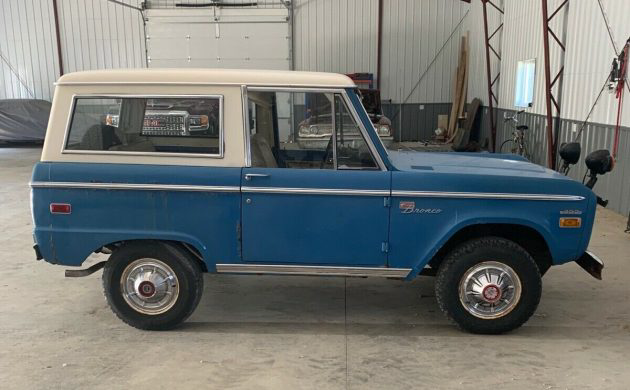
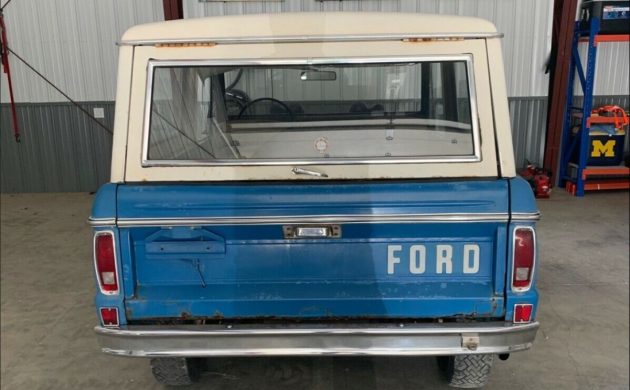
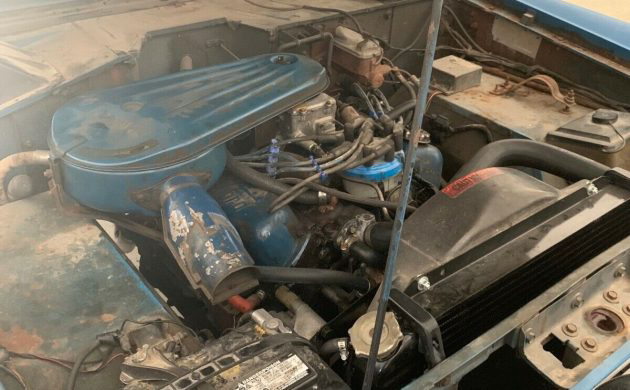
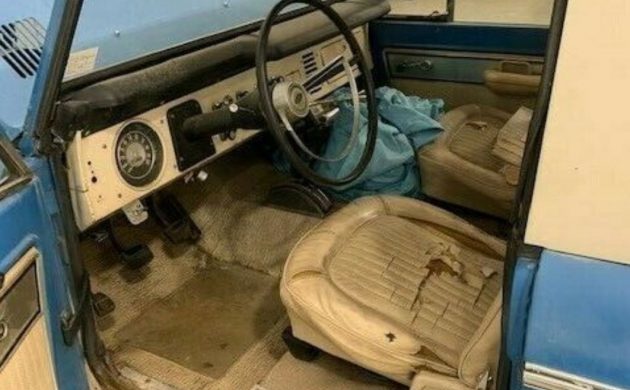
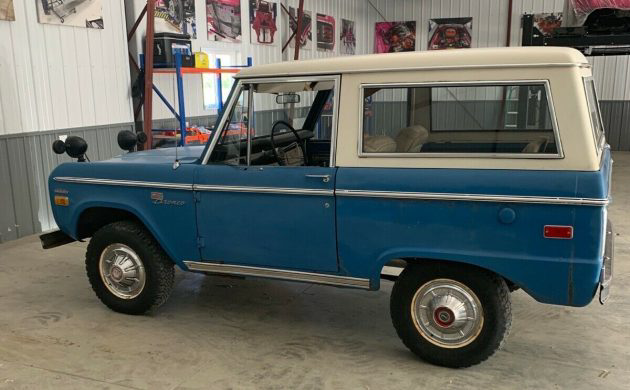


3 speed auto, great find, enjoy it as is.
sorry meant 3 speed manual fun to drive. oops. my bad.
Looks like an auto…
She’s a 3 speed manual, Harvey. Automatics didn’t come along in these for 2 more years.
yep the transfer case shifter looks similar to the typical ford auto floor shifter, and its hard to see the brake pedal and column shift in the pic.
Bidding shows how different we all really are. Drove one of these in the Colorado mountains for a year. Scary handling, terrible ride, uncomfortable seats. My boss was almost killed when his rolled at 30 mph. Roll bars are a must have feature with this model. That interior will kill you in a roll over.
Never will ride in another. YMMV
Stock tires look a little dinky.
Mike…I will have to disagree while respecting your opinion. I run stock wheels and “winter tread” tires on my stock ’69 Bronco with stock hubcaps (looks just like the ones on this Bronco). Not every classic Bronco or vehicle needs some modern oversized tires and wheels stuffed in those wheel wells. This was how they camer from factory and if thery are a time capsule from their era for us to maintain then that is how they should look. Add that I take pride that many comment (at stop lights, car cruises, at restaurants) that they love the “stock/original” look of my Bronco. As I often state “It’s only stock once and stock never goes out of style or taste”. For those that want to stuff big tires and wheels under a Bronco then go find a roached out Bronco or one with cut up rear quarters or a fiberglass Bronco tub and go at it. You will certainly blend in with all the others out there doing much the same with their Jeeps and late model trucks and SUVs. And if you still are not catching enough attention then throw in some machismo-sounding exhaust system to boot. But if you truly want to stand out and have your Bronco really turn heads while not only retaining and increase it’s value and desirability over time then stock is the way to go.
Regarding the comment in the writeup on annual sales – a little bit of context is in order. While the Bronco didn’t sell in the numbers like its more famous stablemate, it did pretty well for its time. When the Bronco was introduced in 1966, annual sales in the SUV segment (spread across 5 vehicles) was about 40k/year. The Bronco along sold over 20k units in its first model year, which increased the segment sales by 50% based on the sales of ONE additional vehicle! Not bad at all!
I agree with Todd’s assessment about need for context when discussing classic vehicles.
It is like when comments are made about mileage claims or lack of belief of true miles when many forget that cars and trucks were not driven the tens of thousands of miles per year like they are now and that most people not only did not drive so much like we all do now and in fact cars did not last very long (would rust out, mechanically fail, etc) except for those truly babied by their owners.
But back to the Bronco, those of us of a certain age will know and recall that back then vehicles such as the Bronco were purchased for use on ranches, farms, plowing duty, municipalities, outdoorsmen, those who found 4wd was necessary for where they lived, those who wanted to off road on weekends and commute a few miles to workplace during week, and those who wanted to drive something “different”. Same thing for the traditional Jeep whether it be civilian Willys models or later AMC CJ (civilian Jeep) models.
While the later Broncos along with the Chevy Blazer/GMC Jimmy and Dodge Ramcharger would see some sales in the 1970s but still hampered by high gas prices to become mainstream followed by Jeep Cherokee and Grand Cherokee having some moderate success in the 1980s, it would not be until the Ford Explorer debuted in the 1990s followed by comparable models by other manufacturers that SUVs (and accompanied by cheap under $1 a gallon gas coupled with prolonged economic prosperity in the 1990s) became the mainstream form of transportation that would be favored by so many the past 30 years only to most recently be surpassed by the Crossover that melded SUV and passenger cars into one.
think of all the similar models @ the time, how equipped (they R often ‘sleeper’ modded today to match modern conditions):
“…Scary handling, terrible ride, uncomfortable seats. My boss was almost killed when his rolled at 30 mph. Roll bars are a must have feature with this model. That interior will kill you in a roll over….”
I’ve dailied my no probs 39 yrs…